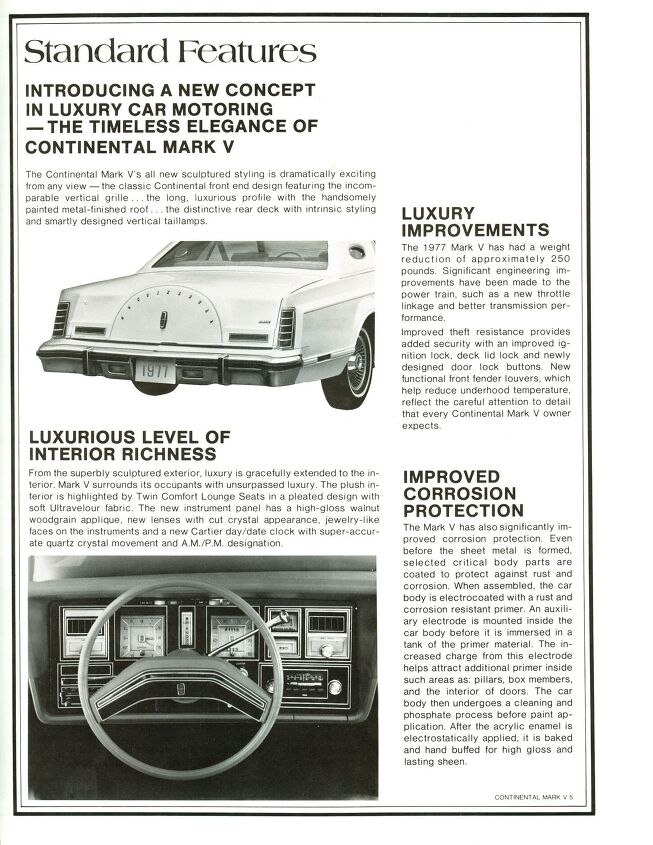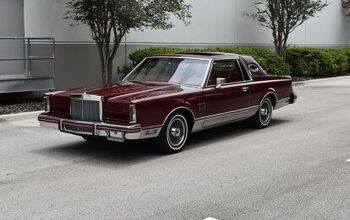Rare Rides Icons: The Lincoln Mark Series Cars, Feeling Continental (Part XXV)

As we move on to the 25th entry in our Lincoln Mark saga, it’s the second week in a row where we’ll focus entirely on Mark V trim packages. Last week we discussed the various iterations of the Luxury Group - a variety of color themes for the Mark V’s interior. Luxury Group options served as a starting place for the customer to custom-order their Mark V. However, the truly well-heeled PLC customer knew such freedom of choice was inherently sub-par: A Designer Series Mark V cost much more than a Luxury Group car, and its appearance was specified for you.
After the one-year Designer Series experiment on the Mark IV of 1976 proved hugely successful, Lincoln immediately contracted with the same luxury brands for 1977. All four were asked to work up new versions of their signature looks for the Mark V. Lincoln made sure the Designer Series cars would be exclusive and buyers would come back for another by using One Simple Trick.
Everyone would know whether the Mark V they saw on the road was a current-year model, as each of the four Designer Series cars changed their color schemes every year. It was easy to identify if a Designer Series was a ‘77, ‘78, or ‘79. Imagine the intense personal embarrassment of pulling up to the supper club in a prior year Mark V.
The only American designer of the group, Bill Blass, returned in 1977 with a Dark Midnight Blue version of the Mark V. With a standard chamois-colored leather interior, the seats featured inserts textured to look like pigskin. The standard vinyl roof treatment was chamois to match the interior and was finished in Lugano grain. Roof vinyl was a rear ¾ arrangement, or the “Landau” style.
Cartier’s 1977 Mark V was Dove Grey and was the only other non-metallic Designer Series paint of 1977. Its interior was the same Dove Grey color and was available in 1977-only Majestic Velour, or leather. Cartier buyers had a choice with their roof covering, as Dove Grey vinyl was available in Landau or full-length style.
Givenchy cars of 1977 were painted in Dark Jade Metallic, and similarly to the Cartier had a color-matched interior. Cartier also offered its interior accommodation in Majestic Velour or leather. Unique to the Cartier was an exciting and all-new roof treatment: The front half! Covered in a chamois Lugano grain like the Bill Blass, the vinyl was only over the front ¾ of the roof and wrapped over the A-pillars.
Finally, Pucci offered the most color contrast available in a Designer Series that year. Black Diamond Fire Metallic paint was paired with a white leather interior. And though no velour option was offered, Pucci made up for it with black trim across many interior components. The look was finished with a white roof in Cayman grain vinyl, either in Landau or full covering style.
Compared to the Designer Series trim specifications of 1978 and 1979, the 1977 model was certainly the Mark V’s most restrained year. As in 1976, customers paid a hefty sum for the exclusivity of a Designer Series. Considering the Luxury Group’s price of $680 ($3,460 adj.) that year, the Designer Series options were priced at $1,600 ($8,142 adj.) to start. That was the ask for any of the four editions with leather trim. Velour (available only on Cartier and Givenchy) was $2,100 ($10,687 adj.). Funny to think cloth upholstery was the more luxurious and expensive choice at the time.
There were additional options that could be layered on top of any of the Luxury Group or Designer Series cars, like a custom set of luggage in Continental Leather for $1,666 ($8,478 adj.), an attache case for $229 ($1,165 adj.), and owner’s initial door monograms for $15 ($76 adj.), a bargain. All luggage pieces were matched to the car’s interior, but their handles and straps could be ordered in any available color should a contrasting look be desired.
The list of available options, trim and otherwise, is too extensive to cover here, but it’s safe to say there was much the $11,396 ($57,995 adj.) price for the 1977 Mark V did not include. Since a reader inquired, the dual exhaust system was not standard on any Mark V and asked $71 ($361 adj.). The engine block heater was an extra $20 ($102 adj.), and so was cruise control, at $124 ($631 adj.). Seldom selected, the power moonroof was a pricey $938 ($4,773 adj.). Interestingly, it was available in various colors of tint for the glass: brown, silver, gold, light jade, and rose. Packaged with the moonroof was the interior lighting, which was $120 ($611 adj.) as a standalone option.
Before we move on to 1978 (our next entry), we’ve one more trim group to cover. Though it was not a standard Luxury Group and not a Designer Series, it used elements of both. The package was introduced midway through 1977, and its name didn’t make the initial marketing materials.
That suggests it was a way to use up extra trim before the line switched to build the 1978 Mark V. Named the Spring Feature Car, it was available in either the Dove Grey of the Cartier or Dark Blue Metallic of Bill Blass, with those colors repeated on the vinyl roof. The theme continued inside, with a unique Dove Gray and Dark Blue leather interior.
The trim was available from March 1977 through the end of the year. It cost the same $680 ($3,460 adj.) as a standard Luxury Group but had more limited availability. The two-tone upholstery pattern was a bit of a sneak preview, as its design would appear soon after on the 1978 editions of the Cartier and Pucci Mark V.
We’ll pick up next time in 1978 when the Designer Series cars got a bit bolder in their look. As customers proved once more they were willing to pay top dollar for a designer name on their car, Lincoln responded with even more branding and additional contrasting color themes. And as 1978 was the 75th anniversary of Ford, a very expensive commemorative Mark V appeared to celebrate the occasion.
[Images: Ford]
Become a TTAC insider. Get the latest news, features, TTAC takes, and everything else that gets to the truth about cars first by subscribing to our newsletter.

Interested in lots of cars and their various historical contexts. Started writing articles for TTAC in late 2016, when my first posts were QOTDs. From there I started a few new series like Rare Rides, Buy/Drive/Burn, Abandoned History, and most recently Rare Rides Icons. Operating from a home base in Cincinnati, Ohio, a relative auto journalist dead zone. Many of my articles are prompted by something I'll see on social media that sparks my interest and causes me to research. Finding articles and information from the early days of the internet and beyond that covers the little details lost to time: trim packages, color and wheel choices, interior fabrics. Beyond those, I'm fascinated by automotive industry experiments, both failures and successes. Lately I've taken an interest in AI, and generating "what if" type images for car models long dead. Reincarnating a modern Toyota Paseo, Lincoln Mark IX, or Isuzu Trooper through a text prompt is fun. Fun to post them on Twitter too, and watch people overreact. To that end, the social media I use most is Twitter, @CoreyLewis86. I also contribute pieces for Forbes Wheels and Forbes Home.
More by Corey Lewis
Latest Car Reviews
Read moreLatest Product Reviews
Read moreRecent Comments
- ToolGuy There was a time when in a place called America there were roads, and they were paved, and they were paved smoothly enough for a vehicle like this. Perhaps our next President will bring back that concept.
- ToolGuy I suppose I will listen before commenting. (TG, what a fair-minded dude!)
- ToolGuy "The technology is much more advanced to be better than a role model driver,”• Do any of you know what a "role model driver" is? No, I guess you wouldn't. 😉
- ToolGuy I might be Batman.
- Lou_BC Well, I'd be impressed if this was in a ZR2. LOL









































Comments
Join the conversation
This (the designer edition thing) was Smart -- as smart as the modern Dodge special editions.
The one you wanted was the Mario Puzo Edition (missed opportunity for Lincoln).
My first car was a 1976 Mark IV (in 1986). I think it may have been a Lux Pkg, not positive. It was the nm maize-cream exterior with full dk brown padded roof and matching brown leather interior. Had it for a year, but the mpgs forced a high school kid to trade it (for an army green standard-base Mark VII since it was better on gas lol). I was an oddball child who preferred luxury cars to sporty cars. Still do (I have a 2010 Mercedes E350 now). Too bad FoMoCo is fixated on SUV and CUVs and has eliminated all sedans. I would love to see a retro themed Mark IV, V, or VII (VI was a waste of time imo). There'd be one in my garage! If I could find an ultra low mileage (sub 20,000 mi) VII Blass, I'd buy it today. May have to sell a kidney or 2 but it'd be worth it! ((Sorry so long winded))